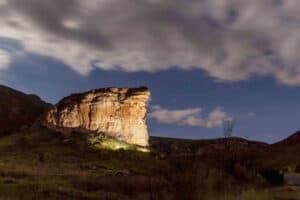Safe enough when tightly controlled but never tamed, fire is simultaneously a devastator and the engine of civilisation.

Fire can also be a tool for growth and regeneration in the bush, and when tourists drive past large swathes of burnt-out Kruger National Park, it’s South African National Parks Scientific Services’ abiotic scientist Tercia Strydom keeping an eye on things.

South African National Parks’ Scientific Services’ abiotic scientist Tercia Strydom speaks about fires in the Kruger National Park. Picture: Amanda Watson
Strydom is part of a team of people from various departments, such as Conservation Management, Ranger Services and Scientific Services, who all ensure fires are used safely and appropriately for maintaining ecosystem health.
“Fire, water, soil, climate – each tough topics on their own – fall under my watch. As an abiotic scientist I work with some of the less emotional topics, unlike elephant, rhino, and lion,” Strydom said.
“Then I remember, oh yes, fire. It can be a tricky subject for some people who consider fire to be bad for the environment. But fire is a critical and natural phenomenon which promotes biodiversity in savannah ecosystems,” Strydom said.
“For example, without fire, grassy areas may get overrun by woody vegetation, with cascading effects on other aspects of biodiversity that are dependent on open and grassy habitats. In fact, you need a range of grassy and woody vegetation to accommodate all biodiversity in savannahs, and fire is a critical natural driver ensuring this tree-grass mixture.”
The Kruger is some 350km long between its furthest points, with Limpopo National Park in Mozambique on its eastern border, and farms, towns, game ranches and lodges along its western border in South Africa.
The park has a long and rich history of fire research and experimentation.
Contrary to popular belief, its ongoing and well-known fire experiment is not the longest running in the country.
That accolade goes to the Ukulinga experimental plots of the University of KwaZulu-Natal.
However, Ukulinga is not nearly as diverse – or as large – as Kruger’s fire plots, which have been running uninterrupted since 1952. Since its inception, more than 100 academic theses, journal articles, reports and datasets have been produced from research conducted on the Kruger experimental burn plots.
Mapping fires caused by poachers and lightning or implemented by management is an important function to understand how the ecosystem works.
In decades past, scientists used to hand-draw burnt areas on to maps of the Kruger.
Now Strydom and colleagues in SANParks Scientific Services’ Geographical Information Systems (GIS) laboratory use images from the Moderate Resolution Imaging Spectroradiometer (Modis), a key instrument aboard the Terra and Aqua satellites that pass over the park daily.
“These maps are important for annual monitoring and evaluation of veld fires,” Strydom noted.
“Merging the old and the new techniques, Kruger now has one of the oldest spatially explicit recorded fire histories in African savannahs, creating unique learning opportunities exploited by scientists locally and abroad.”

A zebra looks for fresh grass after a fire in the Kruger National Park. Picture: Amanda Watson
The Kruger – and all properties with similar fire-prone environments and land uses – is required by law to burn fire breaks.
Burning during the fire season is controlled by the National Veld and Forest Fire Act, is strictly governed, and usually runs from July to October.
“You can imagine the logistics behind burning the entire boundary of the Kruger every year, which is roughly 1000 km long. Teams from Working on Fire, an Extended Public Works Programme, come in to assist us as they have the manpower and the equipment to do these firebreaks on such a massive scale. Our infrastructure, such as camps, also need to be secured through firebreaks or grass slashing,” said Strydom.
Kruger’s fire management strategy has gone through many changes since 1926, Strydom explained.
As more research is done and practical lessons learned, the strategy is adapted based on the best possible knowledge and information at the time.
Currently, its integrated fire management strategy recognises different parts of the park have different fire regimes and requirements.
Some parts of the Kruger experience hot, frequent fires, some have cooler, infrequent fires, and some are subjected to very limited fires. These zones have been determined using the rainfall patterns, geology and historical fire records throughout the park.
Strydom noted that there are specific ecological reasons for the types of fires prescribed in certain parts of the park based on many years of research and expert knowledge.
“The strategy allows for both controlled burns and for natural fires to take place and acknowledges the role man-made fires play in a system of which people have been a part of for thousands of years,” Strydom said.
It’s a case of the more they learn, the more they know for SANParks’ scientists and, like the voracious beast they study, too much is never enough.






